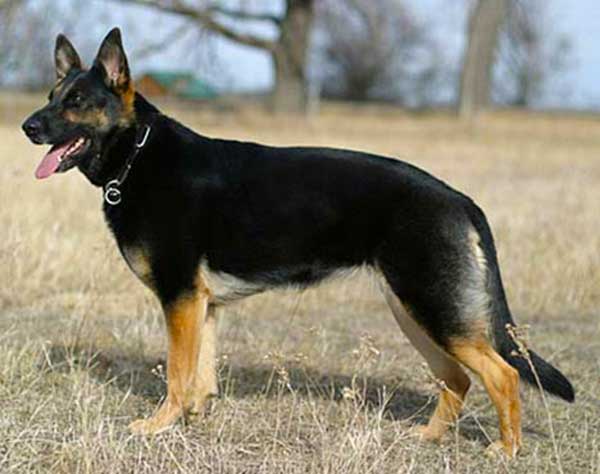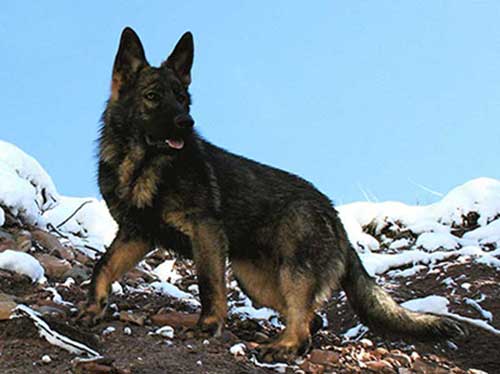The DDR German Shepherd is a dog that has received a lot of attention in recent years.
On one side there are the dog owners that are curious as to the pros and cons of owning this sub-breed of GSD. On the other, there are the breeders that are keen to protect this dog before it is lost completely.
This guide to DDR shepherds will look at some of the important topics regarding the breed in order to offer more insight for GSD lovers that are less familiar with this type.
We will look at the history of the breed, its decline, the desire to keep breeding them and their current status in the GSD world.
There are some that would say that the Czech GSD is the more desirable linage but, as you will see, it is not as simple as all that.
Table of Contents
What is a DDR shepherd and where do they come from?
The best place to start with these dogs is to look at their origin.
These animals could also be referred to as East German shepherds, although DDR is more precise.
East Germany and West Germany were formed during the Cold War when the country was split in two and the Berlin Wall was formed. East Germany was also known as Deutsche Demokratische Republik – its German name – and this is where we get the name DDR shepherd.
The DDR German shepherd history basically began with a desire to breed the best characteristics in dogs on the Eastern side of the wall, and essentially surpass the West German Shepherd dogs.
They were required to climb higher, run further and endure tough weather conditions.
This was all to to ensure that they were strong, unbeatable work dogs for the Border Police. They would track deserters and help to keep order.
Do these East German DDR dogs still exist if there is no DDR anymore?
It is now much more difficult to find pure DDR German shepherds because of the breeding of the German Shepherd today. There are different types by region, but mixed breeding means that many modern GSDs have a mixed bloodline. Then there is the treatment of the dog in the 1980s.
In 1989, the wall came down and the dogs were no longer required, much like the 50,000 or so border guards. The dogs’ fates were varied. Some were sold off for similar roles while others were put down.
Just months after the border opened about 50,000 guards were dismissed from duty, and the DDR dogs were either abandoned, put down or sold to others that would use them for similar purposes.
So does this mean there are no DDR German shepherd breeders in Germany?
The answer is no. Despite the decline of the species, there is still a number of breeders across the world that are working hard to keep the breed going with a strong bloodline.
They are working to preserve the DDR line in a form that most closely represents the standards of the original dog of East Germany. They are a rarity, and getting rarer, but have not been completely breed out yet.
Does this rarity mean that DDR shepherds more desirable than their counterparts?
The breeding methods across the borders lead to different dogs with different temperaments and a slightly different look. They are all GSDs at their core, but there are subtle differences.
There are some prospective DDR GSD owners that wonder whether or not these DDR dogs are better or worse than their cousins. Stories about personality differences will always come into play here. Then there is the look of the dog.
The look of the DDR is attractive for breeders and owners that love the shape of the GSD. The DDR German shepherd size is certainly not diminutive. They simply couldn’t be in order to keep up with all those physical requirements.
They were bred to large heads – perhaps a little larger than the Czech and West German lines – and a strong frame with good bones.
This muscular, lean dog was designed to be athletic and powerful, and this should come through in any DDR dog today. They will have those broad shoulders, sloping backs, large chests and good muscles. The coats also tended to be a little darker and coarser than their counterparts, and this can also be retained.
It should also be remembered that if any of these dogs showed signs of a weak temperament or genetic illness, they were not bred with. Hip dysplasia is common in GSDs. However, DDR East German shepherd pups mostly had this bred out of them to keep them strong and reliable for endurance.
The presence of hip dysplasia is now pretty rare in DDR German Shepherds because these Cold War breeder were so thorough with their standards. There is still the chance of it developing, however. Also, the standard GSD still has hip dysplasia that gets passed down from generation to generation and this could come into play with crossed GSDs.
So the Eastern DDR is stronger, but is it more desirable as a pet dog?
There is quite the debate between in the fight of the DDR vs Czech German shepherd.
The Czech shepherd appears to be the one that GSD lovers lean towards in terms of their temperament, training and general desirability.
As with all dogs, there are some owners and breeders that become fixated on one very specific line and become biased towards that dog, perhaps overlooking any issues in the meantime. However, the consensus does seem to swing away from the DDR. Why is this? It is due to looks, temperament or other issues?
The DDR German shepherd temperament is strong and there are many that dispute the issues of handler sensitivity and a general wariness around strangers.
DDR dogs are known to be very loyal to their pack, which means their family, master and all those within the territory of the house. There is therefore a natural protective instinct to guard your family and that territory from any perceived threat.
There are also those that question the maturity of these dogs, stating that DDR dogs take a while to mature and need a little patience. Some would counter that the Czech dogs are just as problematic in this department and that you can never really tell how a GSD will turn out. You simply have to give them the time and effort they deserve while respecting their ways and their intelligence.
At their core, these stocky animals are still protective, tough working dogs.
The idea of DDR German shepherds as tough, guard dogs comes from their background as working dogs. This Eastern German shepherd is like the other types of GSD in that they are intelligent, strong dogs that are ideal choices for military work, police work and security.
Their tracking skills also mean that they are very well suited to more people-friendly roles, such as within search and rescue operations.
This could be another important reason for the decline in popularity of the DDR shepherd over the Czech or West German options. Many appreciate this breed for its stature, strength and ability as a keen working dog.
However, there is less of a call for such specialised dogs today. Families would rather have a gentler, less intimidating GSD with a Czech line than one that can be easily trained into a guard dog.
As for military and police needs, there are plenty of modern GSD lines and other shepherd breeds that are just as beneficial. The DDR is not an unappealing dog, it has plenty of strong characteristics, but it served its purpose as a specialised breed a long time ago and the general GSD is now the top dog.

Is it really worth looking for a DDR shepherd?
The German DDR clearly had its place in history and showcases an important line in the linage of the GSD as we know it today.
There is the concern from some dog owners that there are people searching for the DDR shepherd as some sort of designer dog.
The fear is that there is some misconception that is superior to the “standard” GSDs that are found. Some seem to be hoping that this historical line is some sort of pinnacle in GSD dog breeding.
The problem is that GSD lovers may be looking for something that isn’t there. The DDR shepherd came about through intense breeding and a need for an East German dog that meet the needs of the country. Those that survived past the Cold War and the reunification of Germany will have passed on their genes, but a pure bloodline is rare.
GSD lovers can argue about the pros and cons of the DDR vs. West German shepherd vs Czech shepherd for a long as they want. Some will have some valid points about the strength, maturity and temperament of each sub-breed.
However, the array of modern day GSDs with mixed heritage shows that the lines between the three are pretty blurred. Either way, it is still admirable that German breeders want to protect the bloodline and retain the DDR German Shepherd.
Featured Image: germanshepherds.com



